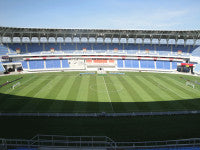Project Angola
How did you become involved and when where you awarded the contract?
 SIS was approached by both the Confederation of African Football and the organisers to carry out a review of the pitches and training centres in Angola. We have installed pitches at FC Porto, Benfica and Sporting Lisbon in Portugal, and there are very close connections between Angola and Portugal as it is a former Portuguese colony.
SIS was approached by both the Confederation of African Football and the organisers to carry out a review of the pitches and training centres in Angola. We have installed pitches at FC Porto, Benfica and Sporting Lisbon in Portugal, and there are very close connections between Angola and Portugal as it is a former Portuguese colony.
How many pitches/stadiums were you involved with?
We built fourteen pitches in total - four stadium pitches and ten training pitches.
What was the total cost of the pitch builds?
SIS had two contracts in Angola, the construction contract was for $16.0 million, and this included all pitch constructions and the sales of construction equipment. The second contract was for the maintenance of all pitches before, during and after the tournament until the end of March. The value of this contract was $10.0 million.
What was the timescale?
The project was due to start in May 2009, but did not actually start until July. We completed all pitch constructions by the end of October.
What logistic problems did you have in terms of labour, machinery, materials and water?
In total we had twenty-two SIS staff working full time on the project, plus we hired another twenty plus locals to work with us. Importing machines was difficult due to red tape. The supply of sand and gravel to sites took longer than expected (80,000 tonnes of sand and 22,000 tonnes of gravel) as we were located in four cities. Water was a key issue on some sites.
How many British groundsmen did you employ and what was their role?
During construction we had all SIS staff but, for the tournament, I brought in Alan Ferguson (Ipswich Town FC), Chris Hague (Parken Stadium, Norway) and Stephen Bache (Hampden Park) to manage the stadium pitches, coordinate the training programmes for the teams and, in general, bring a professional approach to this aspect of the tournament.
How many local people were employed and what was their role?
Twenty in construction and about forty in maintenance. Our objective was to train a group of locals in maintenance so that they could carry on when we departed in March. So far this has worked.
Where did you source your machinery and materials?
We sourced all machines and materials from Europe. We purchased eleven tractors, plus trailers, sprayers, mowers etc. through the UK, Portugal and Holland. In all we purchased over £1.0million of equipment.
What was the general spec of the pitches?
All pitches were Bermuda Princess grass, with the exception of the city of Lubango which was ryegrass. Construction was standard - 100mm of gravel, 250mm of sand and 100m of rootzone. The rootzone was mixed on site and the peat imported.
What problems, if any, did you encounter during the building of the pitches?
I could write a book here but, suffice to say, it was the greatest challenge any of us has ever had.
Maintenance of pitches - what was the height of cut, mowing frequency, feeding etc?
The Bermuda was cut daily to 23mm, with feeding every eight days. It was very intensive
Were there any disease and turf issues?
No major issues.
Were the organisers pleased with the final product?
Yes, very pleased, even though they did their best to destroy the main stadium pitch by having 9,000 people dancing on it for three nights before the opening game! All pitches played well and Samuel Eto'o was quoted as saying "The best pitches he has every played on in any Africa Cup of Nations".
How did they perform?
They all played well, but the tournament had only four stadiums, and each stadium had nine games, nine training sessions, a warm up session of four hours - and all of this is in twenty days. That is too intensive for the Angolan climate - we were lucky we brought Stephen, Chris and Alan over with us.
What did you learn from this experience?
We have written a four page document on how to do it again. The bottom line is everything takes much longer. You need patience and be prepared to think outside of the box. It is difficult working in an environment where you are surrounded by poverty and people dying.
It must have been very rewarding to see the pitches in action?
Absolutely, and the feedback was excellent. We have gained considerable expertise and have been invited to four countries to discuss their existing stadiums and facilities.
What will happen to the pitches now and who will be looking after them?
We have trained local people. I hope the pitches will survive after we leave as we have put a huge amount of work into them. You can never know, but they have all the machines and the knowledge, so fingers crossed!
